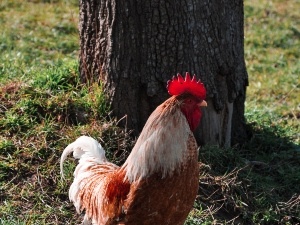
Beak problems in chickens aren’t an uncommon thing, these birds can suffer broken beaks, scissored beaks, and even beaks that are peeling or flaking.
If your chicken’s beak is suddenly peeling, and you’re wondering why, then this article will be of help to you.
Table of Contents
Chicken beak peeling:
Issues with the bird’s beak can lead to difficulties eating, drinking, and clucking. Issues with the bird’s beak may also lead to infections.
Thus, maintaining a healthy chicken beak is of the most upmost importance. Here is why your chicken’s beak may be peeling:
Rough scratching:
Chickens are very curious animals, these birds use their beaks to dig in the grass looking for food to eat. The beaks bear the brunt of being used on a regular basis.
These birds use their beaks to scratch against soft and hard surfaces and the birds may also use their beaks to scratch against something sharp like the edge of a metal container.
Doing this may cause the keratin on the beak, the hard part of the beak, to start peeling at the scratch site. The bird’s beak will peel this keratin layer off and add a new layer to the damaged area.
What to do:
This isn’t something to worry about, the bird’s beak will eventually smooth out and the flakey peeling parts of the bird’s beak will fall off as the bird continues to free range.
You’d only have to worry about the bird’s beak if the bird is malnourished.
If you want to bird’s beak to quickly go back to looking like normal you can use a nail file to smooth the beak down to normal.
Regular peeling:
Beaks are like fingernails, they are always growing and changing.
Chickens will forage and use their beaks against rough surfaces and this keeps them at a normal length and keeps them looking normal and smooth, but, sometimes the bird’s beak will peel as it grows and changes.
This is a sort of molting for the beaks similar to how the bird’s wings need to molt when needed.
The peeling allows the beak’s old keratin layers to flake off and allows new layers of keratin to emerge during this renewal process.
Chickens in the wild have surfaces that they use to remove this excess peeling keratin and keep the beak looking smooth. You may not have enough of these surfaces on your property to allow chickens to do this.
What to do:
You can leave the bird’s beak as it is, this is a normal and natural process. Don’t try to add oil or anything to help the beak along, birds have been doing this independently without human intervention so the birds will be fine.
If you don’t have any, you can make sure that there are enough rough surfaces that the bird can use to rub their beaks against. The birds will use these as they see fit.
If the bird’s beak continues to peel and does not stop peeling after you’ve offered the hard surfaces to scratch on, then you may need to take the bird to a vet. A general vet will be adequate but an avian vet is recommended.
Scaley face mites:
The insects that cause scaley leg mites don’t only affect your bird’s legs, they can affect your bird’s beak as well, in this case, they are called scaley face mites.
These mites are eight-legged microscopic insects that can dig into the featherless parts of your bird and cause a variety of problems.
If the mites attack your chicken’s face then they can dig into the keratin in your bird’s beak, they can also burrow into your bird’s eyes. The insects will cause the bird’s beak to look crusty (usually grey or white crusties), flakey, and peel
If your bird has this disease, and the disease becomes more advanced, then the bird may start to look distressed, have its feathers fluffed out, and beak deformities can also develop.
What to do:
You can treat scaley face mites in your chickens using ivermectin. This treatment needs to be used on your bird for over 7 to 10 days to get rid of the mites.
Some infected birds will not show any signs of suffering from this condition, thus, you would need to treat all your birds if one of your birds has this condition.
Giving your bird vitamin A supplements will also help as this will help the bird build up its immunity against the mites.
Rubbing oils like paraffin oil, olive oil, or baby oil are sometimes suggested to suffocate the mites but you would need to consult with your vet about doing this.
If you enjoyed this article then you may also be interested in other chicken related articles. Here are some articles that you may be interested in: Mold In Chicken Coop, Chicken Has A Broken Leg At The Hip, Chicken Missing Its Top Beak, Growth On Chicken Beak, Baby Chick Not Moving

